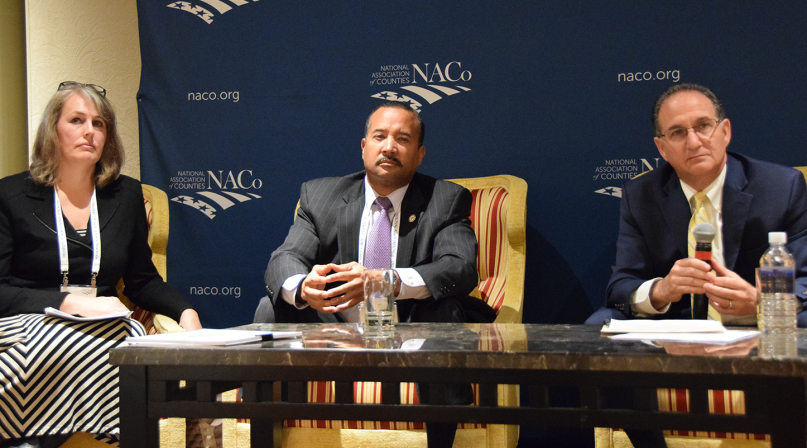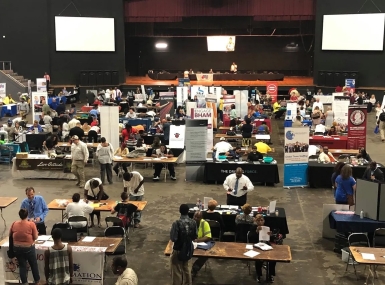Mental illness isn’t a crime, panel says
Upcoming Events
Related News

(l-r) Cherryl Ramirez, Mark Foxhall and Judge Steve Leifman field questions on diverting mentally ill persons from jails during a session at the Safe and Secure Counties Symposium. Photo by Charlie BanRapid rehousing of homeless mentally ill jail inmates who’ve served their time reduces recidivism
It seemed like a good idea at the time, decades ago: “deinstitutionalizing” the mentally ill from dreary state hospitals in favor of treatment in local communities. But government dollars didn’t follow the patients in sufficient amounts.
All too often, this has led to “re-institutionalization” — out of hospitals and into jails and prisons. The patients of yesteryear have become today’s inmates, and experts say their numbers are overwhelming local jails, driving up corrections costs and, perhaps most importantly, wrongly funneling people with mental health problems into the criminal justice system.
Reversing that trend was the topic of a recent workshop at the Safe and Secure Counties Symposium in El Paso County, Colo. on Dec. 3.
A judge, a jailer and a behavioral health professional shared strategies to decriminalize mental illness that are working in counties around the country — innovative policies and programs that could be replicated in other communities.
Last year, more than 2 million adults with mental illnesses were incarcerated in the United States, NACo President Sallie Clarke said at the event. “Many would not be in jail if they were receiving the care that they need,” she said. NACo and its partners’ in the Stepping Up Initiative are addressing the problem and will host a national summit in April in Washington, D.C.
On any given day, some 360,000 persons with serious mental illnesses are in U.S. jails and prisons, Miami- Dade County Judge Steve Leifman told the audience, and another 790,000 are under correctional supervision outside of jails
Jail expenses are crippling counties, which spent more than $70 billion on incarceration costs last year, he said. “I don’t know how you’re going to build another road, a sewer plant, a school or a hospital if we don’t get this under control.”
Cherryl Ramirez, executive director of the Association of Oregon Community Mental Health Programs, discussed policies and programs that are working in counties in her state. Douglas County, Neb. Corrections Director Mark Foxhall added the jail-and-prison perspective.
Both agree that community resources play a pivotal role in keeping individuals with mental health and substance use disorders out of jails in the first place — through programs such as mental health courts, crisis intervention training for police and rapid rehousing of homeless mentally ill persons after their release from jails.
Using grant funding, Yamhill County, Ore. (pop. 100,000) hired a community outreach specialist who screens detainees for mental health issues at the time of booking, said Ramirez, who is also the current president of the National Association of County Behavioral Health and Developmental Disability Directors.
This can result in referrals to appropriate treatment rather than jail time. The county witnessed a 12 percent reduction in length of jail stays for persons with “high mental health needs,” in the first six months of 2013 compared the same period in 2011, she said.
Multnomah County (pop. 766,000) has a 911-call Mental Health Transfer Protocol that works with its crisis hotline to route mental health emergency calls to crisis counselors who can defuse volatile situations rather than have police respond which could result in an arrest.
To reduce homelessness as a contributor to recidivism, the county created a Stabilization and Treatment Preparedness (STP) Housing Program in partnership with the county’s community justice and health departments, Ramirez said. STP provides a 24-hour dormitory-style facility with 16 beds, providing males who have mental health issues with short-term, transitional housing upon their release from jail or prison.
All three speakers touted peer support and counseling as important factors in diverting mentally ill persons from jails. The peers are people who are managing or recovering from mental illness or substance use disorders who have prior personal experience with the justice system. In Douglas County, a certified peer support specialist — a former “frequent flyer” due to recidivism — provides mental health services, Foxhall said.
“We need more people like that to help people who are going through it,” Ramirez said.
Leifman said the fact that community mental health systems are “horribly under-resourced,” is another problem that results in persons with mental health problems landing in jail. He outlined a series of “essential elements” that can help to reverse the criminalization of mental illness — pre- and post-incarceration.
It begins with “sequential intercept mapping,” documenting existing services and gaps in programming where mentally ill persons interact with systems such as corrections, courts and community mental health resources.
Miami-Dade has had success with crisis intervention policing, in which law enforcement officers are taught to recognize different types of mental illnesses, de-escalate mental health or substance-use-related crises and direct troubled persons to appropriate treatment and not the criminal justice system.
Trauma-informed care is also important. Ninety-two percent of incarcerated women with serious mental illness were sexually abused as children, Leifman said. Systems of care need to respond in ways that are sensitive to the trauma they may have experienced. Otherwise mental health issues may continue to flare until the root causes are addressed.
Leifman said at least 50 percent of the mental health population in jails are homeless at the time of arrest and will need supportive housing and employment upon release to lessen the chances of recidivism.
“You can’t expect someone to recover if they leave the jail and they’re homeless, need supportive employment,” he said. In addition, persons exiting jail need systems in place to connect them with any public or private benefits, such as insurance, to which they may be entitled. “Without those benefits, they can’t have the insurance to get the services they need, so they’re going to recycle otherwise,” Leifman said .
He also stressed the need for early identification of mental health issues, even in school-age children. In Miami-Dade, primary and secondary school staff receive training to recognize the signs and symptoms of mental illness in students.
“Why wait?” he asked rhetorically. “Are we waiting for them to get sicker and end up in the criminal justice system, when we know that good services can keep them out?”
(Beverly Schlotterbeck, executive editor, and Charlie Ban, senior staff writer, contributed to this report.)
Attachments
Related News

White House launches federal flood standard support website and tool
On April 11, the White House launched a new website and mapping tool to help users with the ongoing implementation of the Federal Flood Risk Management Standard (FFRMS).

Counties offer a second chance after incarceration
From job fairs and housing programs to educational opportunities, counties offer a second chance after incarceration.
